Jonsered YT46-96043019700, 96043019700 Owner’s Manual
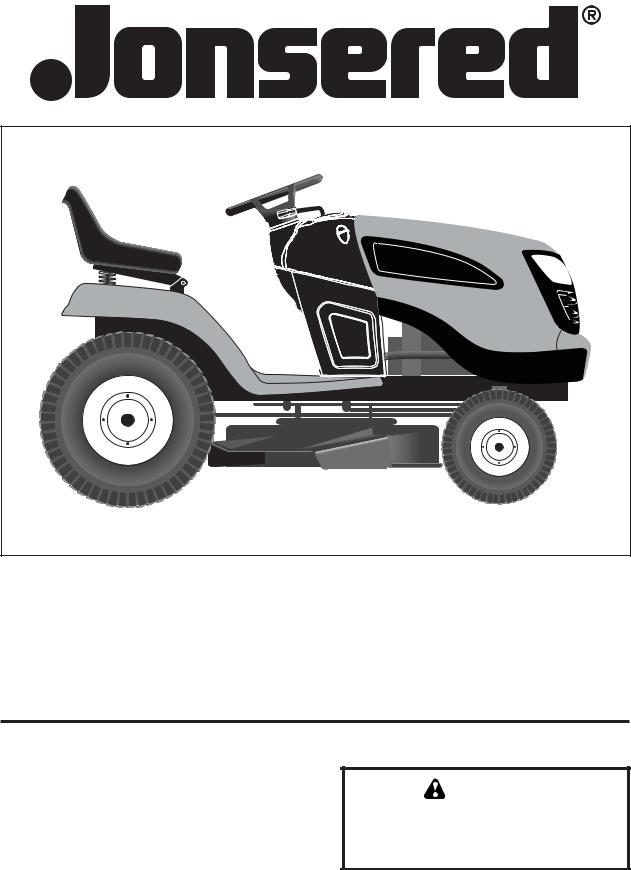
YT46 |
|
Operator's Manual |
WARNING: |
|
Read this Manual and follow all Warnings and Safety Instructions. Failure to do so can result in serious injury.
Gasoline containing up to 10% ethanol (E10) is acceptable for use in this machine. The use of any gasoline exceeding 10% ethanol (E10) will void the product warranty.
587 69 82-26 Rev. 3 |
01.16.18 BD/SR |
Printed in the U.S.A. |
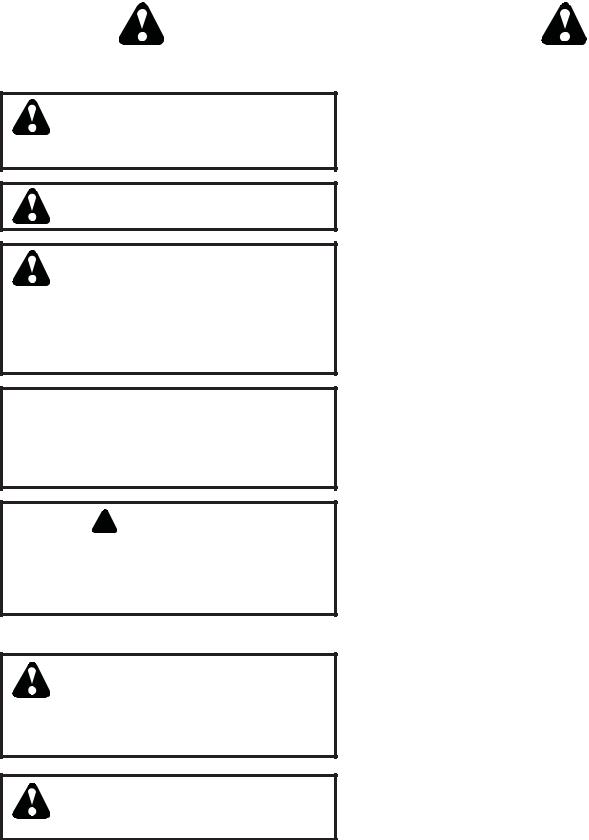
SAFETY RULES
Safe Operation Practices for Ride-On Mowers
DANGER: THIS CUTTING MACHINE IS CAPABLE OF AMPUTATING HANDS AND FEET AND THROWING OBJECTS. FAILURE TO OBSERVE THE FOLLOWING SAFETY INSTRUCTIONS COULD RESULT IN SERIOUS INJURY OR DEATH.
WARNING: In order to prevent accidental starting when setting up, transporting, adjusting or making repairs, always disconnect spark plug wire and place wire where it cannot contact spark plug.
WARNING: Do not coast down a hill in neutral, you may lose control of the tractor.
WARNING: Tow only the attachments that are recommended by and comply with specifications of the manufacturer of your tractor. Use common sense when towing. Operate only at the lowest possible speed when on a slope. Too heavy of a load, while on a slope, is dangerous. Tires can lose traction with the ground and cause you to lose control of your tractor.
 WARNING
WARNING 
Engineexhaust,someofitsconstituents,andcertain vehicle components contain or emit chemicals known to the State of California to cause cancer and birth defects or other reproductive harm.
 WARNING
WARNING 
Battery posts, terminals and related accessories containleadandleadcompounds,chemicalsknown to the State of California to cause cancer and birth defects or other reproductive harm. Wash hands after handling.
I. CHILDREN
WARNING! CHILDRENCANBEINJUREDBY THIS EQUIPMENT. The American Academy of Pediatrics recommends that children be a minimum of 12 year of age before operating a pedestrian controlled lawn mower and a minimumof16yearsofagebeforeoperating a riding lawn mower.
WARNING! CHILDREN CAN BE SERIOUSLY INJURED OR KILLED BY THIS EQUIPMENT. Carefully read and follow all of the safety instructions below.
Tragic accidents can occur if the operator is not alert to the presence of children. Children are often attracted to the machine and the mowing activity. Never assume that children will remain where you last saw them.
•Keep children out of the mowing area and in the watchful care of a responsible adult other than the operator.
•Be alert and turn machine off if a child enters the area.
•Before and while backing, look behind and down for small children.
•Never carry children, even with the blades shut off. They may fall off and be seriously injured or interfere with safe machine operation. Children who have been given rides in the past may suddenly appear in the mowing area for anotherrideandberunoverorbackedoverbythemachine.
•Never allow children to operate the machine.
•Use extreme caution when approaching blind corners, shrubs, trees, or other objects that may block your view of a child.
II. GENERAL OPERATION
•Read, understand, and follow all instructions on the machine and in the manual before starting.
•Do not put hands or feet near rotating parts or under the machine. Keep clear of the discharge opening at all times.
•Only allow responsible adults, who are familiar with the instructions, to operate the machine.
•Clear the area of objects such as rocks, toys, wire, etc., which could be picked up and thrown by the blades.
•Ensure the area is clear of bystanders before operating. Stop machine if anyone enters the area.
•Never carry passengers.
•Do not mow in reverse unless absolutely necessary. Always look down and behind before and while backing.
•Never direct discharged material toward anyone. Avoid discharging material against a wall or obstruction. Material may ricochet back toward the operator. Stop the blades when crossing gravel surfaces.
•Do not operate machine without the entire grass catcher, discharge chute, or other safety devices in place and working.
•Slow down before turning.
•Never leave a running machine unattended. Always turn off blades, set parking brake, stop engine, and remove keys before dismounting.
•Disengage blades when not mowing. Shut off engine and wait for all parts to come to a complete stop before cleaning the machine, removing the grass catcher, or unclogging the discharge chute.
•Operate machine only in daylight or good artificial light.
•Do not operate the machine while under the influence of alcohol or drugs.
•Watchfortrafficwhen operatingnear orcrossingroadways.
•Use extreme caution when loading or unloading the machine into a trailer or truck.
•Always wear eye protection when operating machine.
•Use ear protectors to avoid damage to hearing.
•Data indicates that operators, age 60 years and above, are involved in a large percentage of riding mower-related injuries. These operators should evaluate their ability to operate the riding mower safely enough to protect themselves and others from serious injury.
•Follow the manufacturer's recommendation for wheel weights or counterweights.
•Keep machine free of grass, leaves or other debris build-up which can touch hot exhaust / engine parts and burn. Do not allow the mower deck to plow leaves or other debris which can cause build-up to occur. Clean any oil or fuel spillage before operating or storing the machine. Allow machine to cool before storage.
2
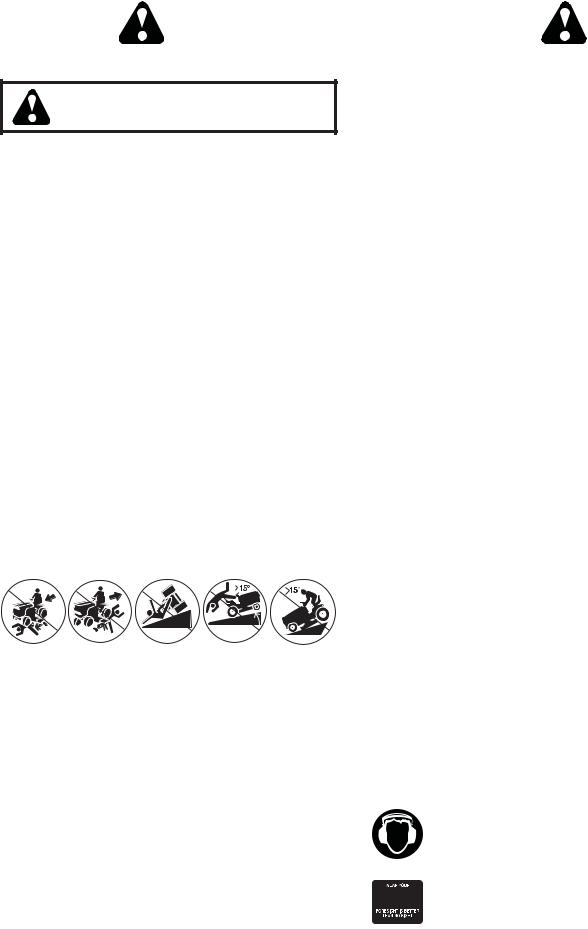
SAFETY RULES
Safe Operation Practices for Ride-On Mowers
III. SLOPE OPERATION
WARNING! When loading or unloading this machine, do not exceed the maximum recommended operation angle of 15°.
Slopes are a major factor related to loss of control and tip-over accidents, which can result in severe injury or death. Operation on all slopes requires extreme caution. If you cannot back up the slope or if you feel uneasy on it, do not mow it.
•Mow up and down slopes, not across.
•Watch for holes, ruts, bumps, rocks, or other hidden objects. Uneven terrain could overturn the machine. Tall grass can hide obstacles.
•Choose a low ground speed so that you will not have to stop or shift while on the slope.
•Do not mow on wet grass. Tires may lose traction. Always keep the machine in gear when going down slopes.
•Do not shift to neutral and coast downhill.
•Avoid starting, stopping, or turning on a slope. If the tires lose traction, disengage the blades and proceed slowly straight down the slope.
•Keep all movement on the slopes slow and gradual. Do not make sudden changes in speed or direction, which could cause the machine to roll over.
•Use extreme caution while operating machine with grass catchers or other attachments; they can affect the stability of the machine. Do no use on steep slopes.
•Do not try to stabilize the machine by putting your foot on the ground.
•Do not mow near drop-offs, ditches, or embankments. The machine could suddenly roll over if a wheel is over the edge or if the edge caves in.
•If machine stops while going uphill, disengage blades, shift into reverse and back down slowly.
•Do not turn on slopes unless necessary, and then, turn slowly and gradually downhill, if possible.
IV. TOWING
•Tow only with a machine that has a hitch designed for towing. Do not attach towed equipment except at the hitch point.
•Follow the manufacturer's recommendation for weight limits for towed equipment and towing on slopes.
•Never allow children or others in or on towed equipment.
•On slopes, the weight of the towed equipment may cause loss of traction and loss of control.
•Travel slowly and allow extra distance to stop.
•Never remove gas cap or add fuel with the engine running.
•Allow engine to cool before refueling.
•Never fuel the machine indoors.
•Never store the machine or fuel container where there is an open flame, spark, or pilot light such as on a water heater or other appliances.
•Never fill containers inside a vehicle or on a truck or trailer bed with plastic liner. Always place containers on the ground away from your vehicle when filling.
•Remove gas-powered equipment from the truck or trailer and refuel it on the ground. If this is not possible, then refuel such equipment with a portable container, rather than from a gasoline dispenser nozzle.
•Keep the nozzle in contact with the rim of the fuel tank or container opening at all times until fueling is complete. Do not use a nozzle lock-open device.
•If fuel is spilled on clothing, change clothing immediately.
•Never overfill fuel tank. Replace gas cap and tighten securely.
GENERAL SERVICE
•Never operate machine in a closed area.
•Keep all nuts and bolts tight to ensure the equipment is in safe working condition.
•Never tamper with safety devices. Never interfere with the intended function of a safety device or reduce the protection provided by a safety device. Check there proper operation regularly. NEVER operate a machine with a safety device that does not function properly.
•Keep machine free of grass, leaves, or other debris buildup. Clean oil or fuel spillage and remove any fuel-soaked debris. Allow machine to cool before storing.
•If you strike a foreign object, stop and inspect the machine. Repair, if necessary, before restarting.
•Never make any adjustments or repairs with the engine running.
•Check grass catcher components and the discharge chute frequently and replace with manufacturer's recommended parts, when necessary.
•Mower blades are sharp. Wrap the blade or wear gloves, and use extreme caution when servicing them.
•Check brake operation frequently. Adjust and service as required.
•Maintain or replace safety and instruction labels, as necessary.
V. SERVICE
SAFE HANDLING OF GASOLINE
To avoid personal injury or property damage, use extreme care in handling gasoline. Gasoline is extremely flammable and the vapors are explosive.
•Extinguish all cigarettes, cigars, pipes, and other sources of ignition.
•Use only approved gasoline container.
Use ear protectors to avoid damage to hearing.
 Always wear eye protectionwhen operating machine.
Always wear eye protectionwhen operating machine.
3

PRODUCT SPECIFICATIONS
Gasoline Capacity |
2.5 Gallons/9,46 L |
|
and type: |
Regular Unleaded |
|
|
|
|
Oil Type: |
SAE 30 (above 32°F/0°C) |
|
(API: SJ-SN) |
SAE 5W30 (below 32°F/0°C) |
|
Oil Capacity: |
W/Filter: |
64 Oz./1,89 L |
|
W/out Filter: |
60 Oz./1,77 L |
|
|
|
Spark Plug: |
RC12YC |
|
|
(Gap: .030"/0,76 mm) |
|
|
|
|
Charging |
3 Amps Battery |
|
System: |
5 Amps Headlights |
|
|
|
|
Battery: |
Amp/Hr: |
28 |
|
Min. CCA: |
230 |
|
Case size: |
U1R |
Blade Bolt Torque: |
45-55 Ft. Lbs./62-75 Nm |
|
|
|
|
CONGRATULATIONS on your purchase of a new tractor. It has been designed, engineered and manufactured to give you the best possible dependability and performance.
Should you experience any problem you cannot easily remedy, please contact your nearest authorized service center/department. Wehavecompetent,well-trainedtechni- cians and the proper tools to service or repair this tractor.
Please read and retain this manual. The instructions will enable you to assemble and maintain your tractor properly. Always observe the “SAFETY RULES”.
CUSTOMER RESPONSIBILITIES
•Read and observe the safety rules.
•Follow a regular schedule in maintaining, caring for and using your tractor.
•Follow the instructions in the Maintenance and Storage sections of this manual.
•Wear proper Personal Protective Equipment (PPE) while operating this machine, including (at a minimum) sturdy footwear, eye protection, and hearing protection. Do not mow in shorts and/or open toed footwear.
•Always let someone know you are outside mowing.
WARNING: This tractor is equipped with an internal combustion engine and should not be used on or near any unimproved forest-covered, brush-covered or grasscovered land unless the engine’s exhaust system is equipped with a spark arrester meeting applicable local or state laws (if any). If a spark arrester is used, it should be maintained in effective working order by the operator.
A spark arrester for the muffler is available through your nearest authorized service center/department.
In the state of California the above is required by law (Section 4442 of the California Public Resources Code). Other states may have similar laws. Federal laws apply on federal lands.
TABLE OF CONTENTS
SAFETY RULES ................................................................... |
2-3 |
PRODUCT SPECIFICATIONS................................................. |
4 |
CUSTOMER RESPONSIBILITIES........................................... |
4 |
ASSEMBLY........................................................................... |
5-6 |
OPERATION ....................................................................... |
7-13 |
MAINTENANCE SCHEDULE ................................................ |
14 |
MAINTENANCE............................................................... |
14-18 |
SERVICE AND ADJUSTMENTS...................................... |
19-24 |
STORAGE.............................................................................. |
25 |
TROUBLESHOOTING...................................................... |
26-27 |
4

UNASSEMBLED PARTS
ASSEMBLY
Your new tractor has been assembled at the factory with the exception of those parts left unassembled for shipping purposes.
TOOLS REQUIRED FOR ASSEMBLY
A socket wrench set will make assembly easier. Standard wrench sizes are listed.
(1) |
1/2" wrench |
Tire pressure gauge |
|
(2) |
7/16" wrenches |
Utility knife |
Pliers |
When right or left hand is mentioned in this manual, it means when you are in the operating position (seated behind the steering wheel).
TOREMOVETRACTORFROMCARTON
UNPACK CARTON
•Remove all accessible loose parts and parts cartons from carton.
•Remove end panels and lay side panels flat.
•Check for any additional loose parts or cartons and remove.
BEFORE REMOVING TRACTOR FROM SKID
CONNECT BATTERY (See Fig. 1)
WARNING: Donotshortbatteryterminals by allowing a wrench or any other object to contact both terminals at the same time. Before connecting battery, remove metal bracelets, wristwatch bands, rings, etc. Positive terminal must be connected first to prevent sparking from accidental grounding.
NOTE: If this battery is put into service after month and year indicated on label (label is located between terminals) charge battery for minimum of one hour at 6-10 amps. (See “BATTERY” in the Maintenance section of this manual for charging instructions.)
•Determine battery location. Battery location will be under the seat or the hood.
•Lift seat pan or hood to raised position.
•Remove two terminal caps and discard.
•First connect RED battery cable to positive (+) terminal with bolt and nut as shown. Tighten securely. Slide terminal cover over terminal.
•Connect BLACK grounding cable to negative (-) terminal with remaining bolt and nut. Tighten securely.
•Lower seat pan or hood.
NOTE:Forbattery installationsee“REPLACINGBATTERY” in the Service and Adjustments section in this manual.
TERMINAL |
NUT |
TERMINAL |
|
COVER |
LABEL |
CAP |
|
|
|
||
|
|
BOLT |
|
POSITIVE |
|
NEGATIVE |
|
(RED) |
|
||
|
(BLACK) |
||
CABLE |
|
||
02605 |
CABLE |
||
|
Fig. 1
ADJUST SEAT (See Fig. 2)
•Sit in seat.
•Lift up adjustment lever (A) and slide seat until a comfortable position is reached which allows you to press clutch/brake pedal all the way down.
•Release lever to lock seat in position.
A |
Fig. 2
5

ASSEMBLY
NOTE: You may now roll your tractor off the skid. Continue using the instructions that follow to remove the tractor from the skid.
 WARNING: Before starting, read, understand and follow all instructions in the Operation section of this manual. Ensure tractor is in a well-ventilated area. Ensure the area in front of tractor is clear of other people and objects.
WARNING: Before starting, read, understand and follow all instructions in the Operation section of this manual. Ensure tractor is in a well-ventilated area. Ensure the area in front of tractor is clear of other people and objects.
TO ROLL TRACTOR OFF SKID (See Operation section for location and function of controls)
•Raise attachment lift lever to its highest position.
•Release parking brake by depressing clutch/brake pedal.
•Place freewheel control in "TRANSMISSION DISENGAGED" position. (See “TO TRANSPORT” in the Operation section of this manual.)
•Roll tractor forward off skid.
•Remove banding holding the deflector shield up against tractor.
Continue with the instructions that follow.
CHECK TIRE PRESSURE
The tires on your tractor were overinflated at the factory for shipping purposes. Correct tire pressure is important for best cutting performance.
•Reduce tire pressure to PSI shown on tires.
CHECK DECK LEVELNESS
For best cutting results, mower housing should be properly leveled. See “TO LEVEL MOWER HOUSING” in the Service and Adjustments section of this manual.
CHECK FOR PROPER POSITION OF ALL BELTS
See the figures that are shown for replacing motion and mower blade drive belts in the Service and Adjustments section of this manual. Verify that the belts are routed correctly.
CHECK BRAKE SYSTEM
After you learn how to operate your tractor, check to see that the brake is operating properly. See “TO CHECK BRAKE” in the Service and Adjustments section of this manual.
CHECKLIST
BEFORE YOU OPERATE YOUR NEW TRACTOR, WE WISH TO ASSURE THAT YOU RECEIVE THE BEST PERFORMANCE AND SATISFACTION FROM THIS QUALITY PRODUCT.
PLEASE REVIEW THE FOLLOWING CHECKLIST:
All assembly instructions have been completed.
No remaining loose parts in carton.
Battery is properly prepared and charged.
Seat is adjusted comfortably and tightened securely.
All tires are properly inflated. (For shipping purposes, the tires were overinflated at the factory).
Be sure mower deck is properly leveled side-to-side/ front-to-rear for best cutting results. (Tires must be properly inflated for leveling).
Check mower and drive belts. Be sure they are routed properly around pulleys and inside all belt keepers.
Check wiring. See that all connections are still secure and wires are properly clamped.
Before driving tractor, be sure freewheel control is in “transmission engaged” position (see “TO TRANSPORT” in the Operation section of this manual).
WHILE LEARNING HOW TO USE YOUR TRACTOR, PAY EXTRA ATTENTION TO THE FOLLOWING IMPORTANT ITEMS:
Engine oil is at proper level.
Fuel tank is filled with fresh, clean, regular unleaded gasoline.
Become familiar with all controls, their location and function. Operate them before you start the engine.
Be sure brake system is in safe operating condition.
Be sure Operator Presence System and Reverse Operation System (ROS) are working properly (See the Operation and Maintenance sections in this manual).
It is important to purge the transmission before operating your tractor for the first time. Follow proper starting and transmission purging instructions (See “TO START ENGINE” and “PURGE TRANSMISSION” in the Operation section of this manual).
6
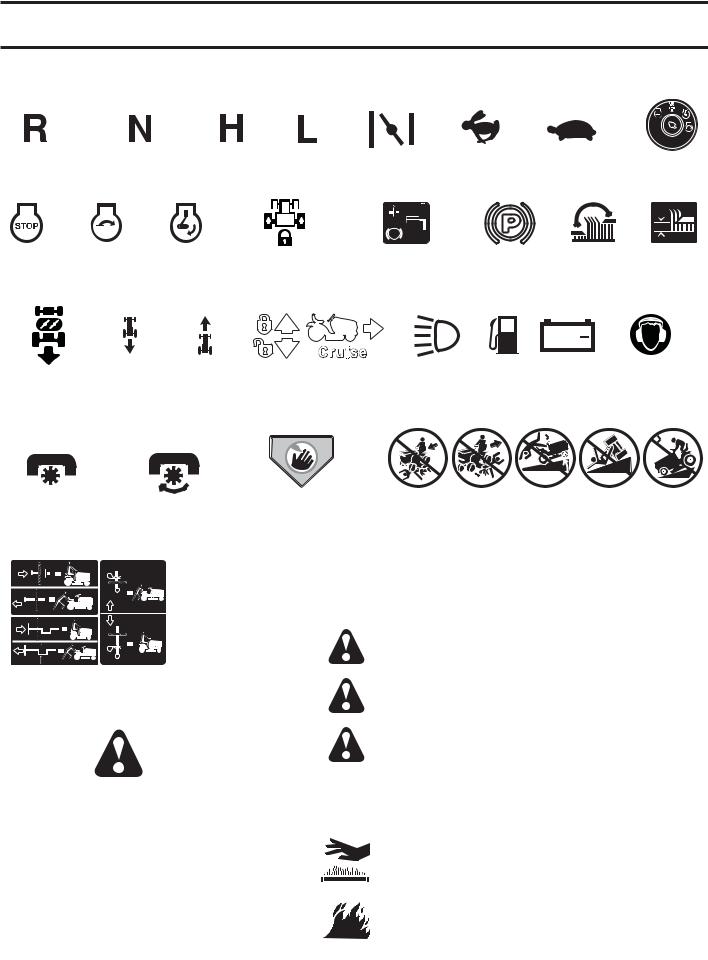
OPERATION
These symbols may appear on your tractor or in literature supplied with the product. Learn and understand their meaning.
REVERSE |
NEUTRAL |
HIGH |
LOW |
CHOKE |
FAST |
SLOW |
IGNITION |
|
|
|
|
|
|
|
SWITCH |
ENGINE |
ENGINE |
ENGINE |
DIFFERENTIAL |
CLUTCH/ |
PARKING |
|
MOWER |
MOWER |
|||
OFF |
START |
ON |
LOCK |
BRAKE PEDAL |
BRAKE |
|
HEIGHT |
LIFT |
|||
|
|
|
|
|
|
|
|
|
|
|
|
|
|
|
|
|
|
|
|
|
|
|
|
|
|
|
|
|
|
|
|
|
|
|
|
REVERSE REVERSE FORWARD |
CRUISE CONTROL |
LIGHTS ON FUEL BATTERY |
EAR |
OPERATION |
|
|
PROTECTION |
SYSTEM (ROS) |
|
|
RECOMMENDED |
|
|
|
|
|
|
15 |
15 |
ATTACHMENT |
ATTACHMENT |
DANGER, KEEP |
KEEP AREA CLEAR |
SLOPE HAZARDS |
||||||||
CLUTCH |
|
|
CLUTCH |
HANDS AND |
(SEE SAFETY RULES SECTION) |
|||||||
DISENGAGED |
|
ENGAGED |
FEET AWAY |
|
|
|||||||
|
|
|
|
|
|
|
|
|
|
|
|
|
|
|
|
|
|
|
|
|
|
|
|
|
|
|
|
|
|
|
|
|
|
|
|
|
|
|
|
|
|
|
|
|
|
|
|
|
|
|
|
|
|
|
|
|
|
|
|
|
|
|
|
|
|
|
|
|
|
|
|
|
|
|
|
|
|
|
|
|
|
|
|
|
|
|
|
|
|
|
|
|
|
|
|
|
|
|
|
|
|
|
|
|
|
|
|
|
|
|
|
|
|
|
|
|
|
|
|
|
|
|
|
|
|
|
|
|
|
|
|
|
|
|
|
|
|
|
|
|
|
|
FREE WHEEL (Automatic Models only)
Failure to follow instructions could result in serious injury or death. The safety alert symbol is used to identify safety information about hazards which can result in death, serious injury and/or property damage.
DANGER indicates a hazard which, if not avoided, will result in death or serious injury.
WARNING indicates a hazard which, if not avoided, could result in death or serious injury.
CAUTION indicates a hazard which, if not avoided, might result in minor or moderate injury.
CAUTION when used without the alert symbol, indicates a situation that could result in damage to the tractor and/or engine.
HOT SURFACES indicates a hazard which,
if not avoided, could result in death, serious injury and/or property damage.
FIRE indicates a hazard which, if not avoided, could result in death, serious injury and/or property damage.
7

OPERATION
KNOW YOUR TRACTOR
READ THIS OPERATOR'S MANUAL AND SAFETY RULES BEFORE OPERATING YOUR TRACTOR
Compare the illustrations with your tractor to familiarize yourself with the locations of various controls and adjustments. Save this manual for future reference.
D |
P |
|
H |
G |
|
|
|
|
|
|
|
|
|
E |
B |
|
|
|
|
A |
|
|
F |
|
|
|
|
|
|
|
C |
J |
|
K |
M |
|
|
|
|
|
|
|
|
L |
Fig. 3
Our tractors conform to the applicable safety standards of the American National Standards Institute.
(A)ATTACHMENT LIFT LEVER - Used to raise and lower the mower or other attachments mounted to your tractor.
(B)BRAKE PEDAL - Used for braking the tractor and starting the engine.
(C)PARKING BRAKE - Locks clutch/brake pedal into the brake position.
(D)THROTTLE/CHOKE CONTROL - Used for starting and controlling engine speed.
(E)ATTACHMENT CLUTCH LEVER - Used to engage the mower blades, or other attachments mounted to your tractor.
(F)IGNITION SWITCH - Used for starting and stopping the engine.
(G)REVERSE OPERATION SYSTEM (ROS) "ON" POSITION - Allows operation of mower or other powered attachment while in reverse.
(H)LIGHT SWITCH - Turns the headlights on and off.
(J)CRUISE CONTROL LEVER - Used to set forward movement of tractor at desired speed without holding the forward drive pedal.
(K)FORWARD DRIVE PEDAL - Used for forward movement of tractor.
(L)REVERSE DRIVE PEDAL - Used for reverse movement of tractor.
(M)FREEWHEEL CONTROL - Disengages transmission for pushing or slowly towing the tractor with the engine off.
(P) SERVICE MINDER / HOUR METER - Indicates when service is required for the engine and mower.
8
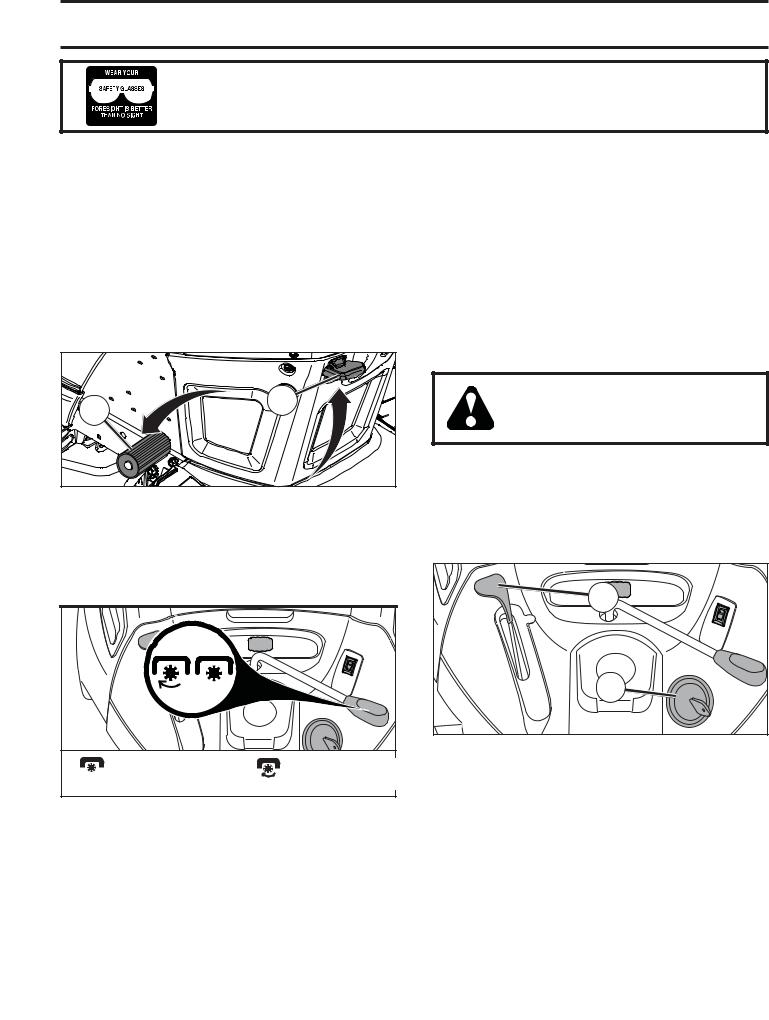
OPERATION
The operation of any tractor can result in foreign objects thrown into the eyes, which can result in severe eye damage. Always wear safety glasses or eye shields while operating your tractor or performing any adjustments or repairs. We recommend standard safety glasses or a wide vision safety mask worn over spectacles.
HOW TO USE YOUR TRACTOR
TO SET PARKING BRAKE (See Fig. 4)
Your tractor is equipped with an operator presence sensing switch. When engine is running, any attempt by the operator to leave the seat without first setting the parking brake will shut off the engine.
•Depress brake pedal (B) all the way down and hold.
•Pull parking brake lever (C) up and hold, release pressure from brake pedal (B), then release parking brake lever. Pedal should remain in brake position. Ensure parking brake will hold tractor secure.
B |
C |
|
Fig. 4
STOPPING (See Fig. 5)
MOWER BLADES -
•To stop mower blades, place attachment clutch control in the “DISENGAGED” position (
 ).
).
( |
) ATTACHMENT |
( |
) ATTACHMENT |
|
CLUTCH LEVER |
|
CLUTCH LEVER |
|
“DISENGAGED” |
|
“ENGAGED” |
Fig. 5
GROUND DRIVE -
•To stop ground drive, depress brake pedal into full “BRAKE” position.
IMPORTANT: FORWARD AND REVERSE DRIVE PEDALS RETURN TO NEUTRAL POSITION WHEN NOT DEPRESSED.
ENGINE -
•Move throttle control (D) to slow position.
NOTE: Failure to move throttle control to slow position and allowing engine to idle before stopping may cause engine to “backfire”.
•Turn ignition key (F) to “STOP” position and remove key. Always remove key when leaving tractor to prevent unauthorized use.
•Never use the choke to stop the engine.
IMPORTANT: LEAVING THE IGNITION SWITCH IN ANY POSITION OTHER THAN "STOP" WILL CAUSE THE BATTERY TO DISCHARGE AND GO DEAD.
NOTE: Under certain conditions when tractor is standing idle with the engine running, hot engine exhaust gases may cause “browning” of grass. To eliminate this possibility, always stop engine when stopping tractor on grass areas.
CAUTION: Always stop tractor completely, as described above, and set parking brake before leaving the operator's position.
TO USE THROTTLE CONTROL (D) (See Fig. 6)
Always operate engine at full speed (fast).
•Operating engine at less than full speed (fast) reduces the engine's operating efficiency.
•Full speed (fast) offers the best mower performance.
D |
F |
Fig. 6
TO MOVE FORWARD AND BACKWARD (See Fig. 7)
The direction and speed of movement is controlled by the forward and reverse drive pedals.
•Start tractor and release parking brake.
•Slowly depress forward (K) or reverse (L) drive pedal to begin movement. Ground speed increases the further down the pedal is depressed.
9
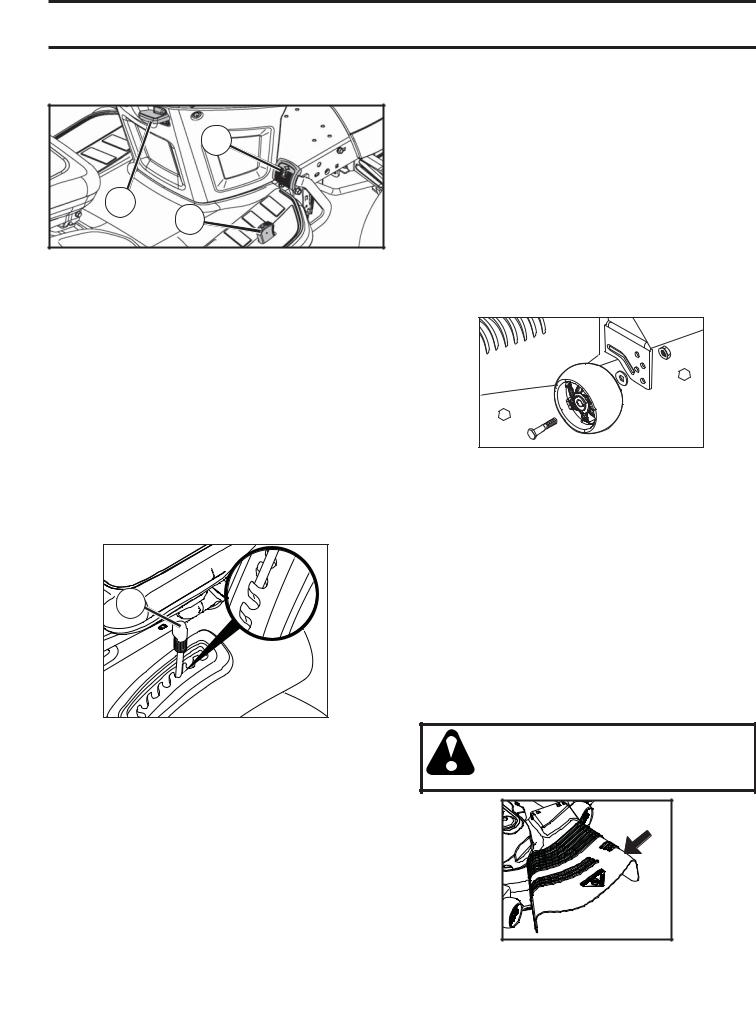
OPERATION
TO USE CRUISE CONTROL (J) (See Fig. 7)
The cruise control feature can be used for forward travel only.
K
J
L
Fig. 7
SYSTEM CHARACTERISTICS
The cruise control should only be used while mowing or transporting on relatively smooth, straight surfaces. Other conditions such as trimming at slow speeds may cause the cruise control to disengage. Do not use the cruise control on slopes, rough terrian or while trimmimg or turning.
•With forward drive pedal depressed to desired speed, pull cruise control lever (J) up and hold while lifting your foot off the pedal, then release the lever.
To disengage the cruise control, depress the brake pedal or tap on forward drive pedal.
TO ADJUST MOWER CUTTING HEIGHT (See Fig. 8)
The position of the attachment lift lever (A) determines the cutting height.
A |
Fig. 8
•Put attachment lift lever in desired cutting height slot.
The cutting height range is approximately 1 to 4" (25,4 to 101,6 mm). The heights are measured from the ground to the blade tip with the engine not running. These heights are approximate and may vary depending upon soil conditions, height of grass and types of grass being mowed.
•The average lawn should be cut to approximately 2-1/2" (63,5 mm) during the cool season and to over 3" (76,2 mm) during hot months. For healthier and better looking lawns, mow often and after moderate growth.
•For best cutting performance, grass over 6" (152,4 mm) in height should be mowed twice. Make the first cut relatively high; the second to desired height.
TO ADJUST GAUGE WHEELS (See Fig. 9)
Gauge wheels are properly adjusted when they are slightly off the ground when mower is at the desired cutting height in operating position. Gauge wheels then keep the deck in proper position to help prevent scalping in most terrain conditions.
NOTE:Adjust gauge wheels with tractor on a flat level surface.
•Adjust mower to desired cutting height. (See “TO ADJUST MOWER CUTTING HEIGHT” in the Operation section of this manual.)
•With mower in desired height of cut position, gauge wheels should be assembled so they are slightly off the ground. Install gauge wheel in appropriate hole as shown and tighten securely.
•Repeat for opposite side installing gauge wheel in same adjustment hole.
9/16” |
3/4” |
Fig. 9
TO OPERATE MOWER
Your tractor is equipped with an operator presence sensing switch. Any attempt by the operator to leave the seat with the engine running and the attachment clutch engaged will shut off the engine. You must remain fully and centrally positioned in the seat to prevent the engine from hesitating or cutting off when operating your equipment on rough, rolling terrain or hills.
•Selectdesiredheightofcut.(See"TOADJUSTMOWER CUTTING HEIGHT".)
•Start mower blades by engaging attachment clutch control.
TO STOP MOWER BLADES
Disengage attachment clutch control.
CAUTION: Do not operate the mower without either the entire grass catcher, on mowers so equipped, or the deflector chute in place (See Fig. 10).
Fig. 10
10
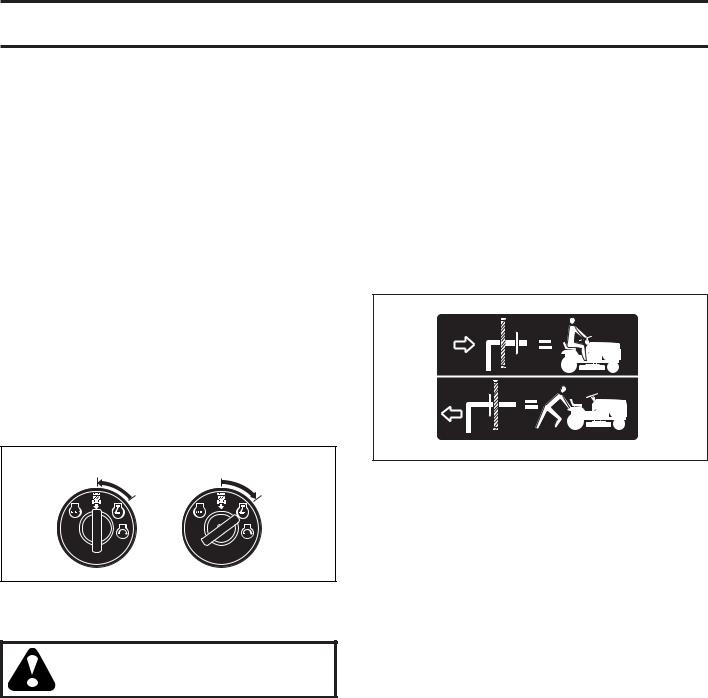
OPERATION
REVERSE OPERATION SYSTEM (ROS) (See Fig. 11)
Your tractor is equipped with a Reverse Operation System (ROS). Any attempt by the operator to travel in the reverse direction with the attachment clutch engaged will shut off the engine unless ignition key is placed in the ROS "ON" position.
 WARNING: Backing up with the attachment clutch engaged while mowing is strongly discouraged. Turning the ROS "ON", to allow reverse operation with the attachment clutch engaged, should only be done when the operator decides it is necessary to reposition the machine with the attachment engaged. Do not mow in reverse unless absolutely necessary.
WARNING: Backing up with the attachment clutch engaged while mowing is strongly discouraged. Turning the ROS "ON", to allow reverse operation with the attachment clutch engaged, should only be done when the operator decides it is necessary to reposition the machine with the attachment engaged. Do not mow in reverse unless absolutely necessary.
USING THE REVERSE OPERATION SYSTEM -
Only use if you are certain no children or other bystanders will enter the mowing area.
•Depress brake pedal all the way down.
•With engine running, turn ignition key counterclockwise to ROS "ON" position.
•Look down and behind before and while backing.
•Slowly depress reverse drive pedal to start movement.
•When use of the ROS is no longer needed, turn the ignition key clockwise to engine "ON" position.
ROS "ON" POSITION |
ENGINE "ON" POSITION |
|
(NORMAL OPERATING) |
02828
Fig. 11
TO OPERATE ON HILLS
CAUTION: Do not drive up or down hills with slopes greater than 15° and do not drive across any slope.
•Choose the slowest speed before starting up or down hills.
•Avoid stopping or changing speed on hills.
•If stopping is absolutely necessary, push brake pedal quickly to brake position and engage parking brake.
•To restart movement, slowly release parking brake and brake pedal.
•Slowly depress appropriate drive pedal to slowest setting.
•Make all turns slowly.
TO TRANSPORT (See Fig. 3 and 12)
When pushing or towing your tractor, ensure transmission is disengaged by placing freewheel control in freewheeling position. Free wheel control is located at the rear drawbar of tractor.
•Raise attachment lift to highest position with attachment lift control.
•Pull freewheel control out until the free wheel control rod locks in extended position.
•Do not push or tow tractor at more than two (2) mph (3,2 km/h).
•To reengage transmission, reverse above procedure.
NOTE: Freewheel control will automatically disengage when the brake/clutch pedal is depressed.
TRANSMISSION ENGAGED
TRANSMISSION DISENGAGED
Fig. 12
NOTE: To protect hood from damage when transporting your tractor on a truck or a trailer, ensure hood is closed and secured to tractor. Use an appropriate means of tying hood to tractor (rope, cord, etc.).
TOWING CARTS AND OTHER ATTACHMENTS
Tow only the attachments that are recommended by and comply with specifications of the manufacturer of your tractor. Use common sense when towing. Too heavy of a load, while on a slope, is dangerous. Tires can lose traction with the ground and cause you to lose control of your tractor.
SERVICE MINDER/HOUR METER
Service minder shows the total number of hours the engine has run and indicates when the engine or mower needs servicing. After every 50 hours of operation the oil can icon will stay on for 2 hours or until a manual reset occurs. To reset the display manually turn the ignition switch to the on position, then the off position five times (1 second on, 1 second off). To service engine and mower, see the Maintenance section of this manual.
NOTE: Service minder runs when the ignition key is in any position but “STOP”. For accurate reading, be sure key remains in the “STOP” position when engine is not running.
11
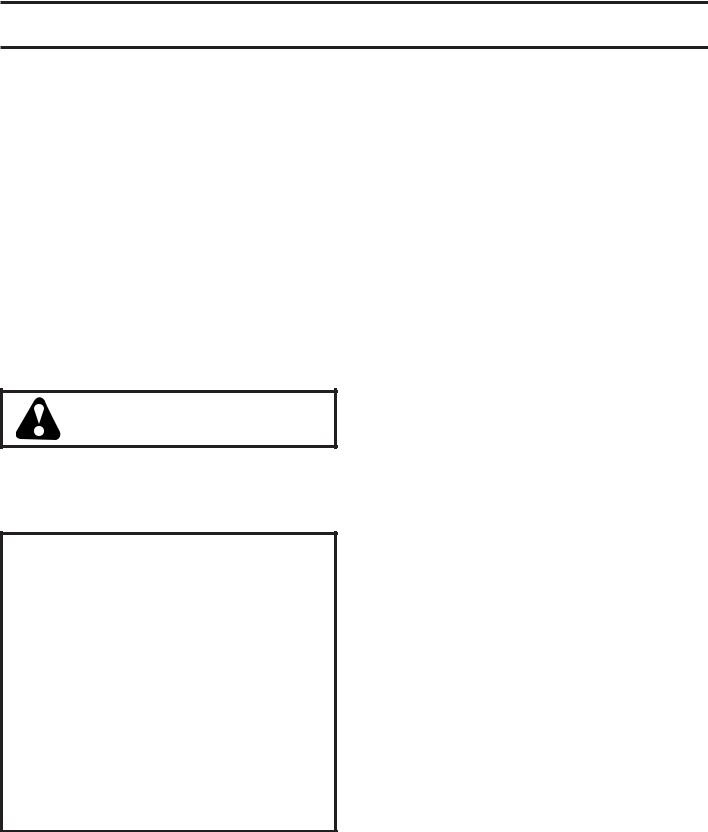
OPERATION
BEFORE STARTING THE ENGINE
CHECK ENGINE OIL LEVEL
The engine in your tractor has been shipped from the factory already filled with summer weight oil.
•Check engine oil with tractor on level ground.
•Remove oil fill cap/dipstick and wipe clean, reinsert the dipstick and screw cap tight, wait for a few seconds, remove and read oil level. If necessary, add oil until “FULL” mark on dipstick is reached. Do not overfill.
•For cold weather operation you should change oil for easier starting. (See “OIL VISCOSITY CHART” in the Maintenance section of this manual.)
•To change engine oil, see the Maintenance section in this manual.
ADD GASOLINE
•Fill fuel tank to bottom of filler neck. Do not overfill. Use fresh, clean, regular gasoline with a minimum of 87 octane. Do not mix oil with gasoline. Purchase fuel in quantities that can be used within 30 days to ensure fuel freshness.
CAUTION: Wipe off any spilled oil or fuel. Do not store, spill or use gasoline near an open flame.
IMPORTANT: WHEN OPERATING IN TEMPERATURES BELOW32°F(0°C),USEFRESH,CLEANWINTERGRADE GASOLINE TO HELP ENSURE GOOD COLD WEATHER STARTING.
CAUTION: Alcohol blended fuels (called gasohol or using ethanol or methanol) can attract moisture which leads to separation and formation of acids during storage. Acidic gas can damage the fuel system of an engine while in storage. To avoid engineproblems,thefuelsystemshouldbeemptied before storage of 30 days or longer. Drain the gas tank, start the engine and let it run until the fuel lines and carburetor are empty. Use fresh fuel next season. See Storage Instructions for additional information. Neveruseengineorcarburetorcleaner products in the fuel tank or permanent damage may occur. Fuel stabilizer is an acceptable alternative in minimizing the formation of fuel gum deposits during storage. Add stabilizer to gasoline in fuel tank or storage container. Always follow the mix ratio found on stabilizer container. Run engine at least 10 minutes after adding stabilizer to allow the stabilizer to reach the carburetor. Do not empty the gas tank and carburetor if using fuel stabilizer.
TO START ENGINE (See Fig. 3)
When starting the engine for the first time or if the engine has run out of fuel, it will take extra cranking time to move fuel from the tank to the engine.
•Be sure freewheel controlis inthe transmission engaged position.
•Sit on seat in operating position, depress brake pedal and set parking brake.
•Move attachment clutch to “DISENGAGED” position.
•Move throttle control to choke position.
NOTE: Before starting, read the warm and cold starting procedures below.
•Insert key into ignition and turn key clockwise to “START” position and release key as soon as engine starts. Do not run starter continuously for more than fifteen seconds per minute. If the engine does not start after several attempts, move throttle control to fast position, wait a few minutes and try again. If engine still does not start, move the throttle control back to the choke position and retry.
WARM WEATHER STARTING (50°F/10°C and above)
•When engine starts, move the throttle control to the fast position.
•The attachments and ground drive can now be used. If the engine does not accept the load, restart the engine and allow it to warm up for one minute using the choke as described above.
COLD WEATHER STARTING (50°F/10°C and below)
•When engine starts, allow engine to run with the throttle control in the choke position until the engine runs roughly, then move throttle control to fast position. This may require an engine warm-up period from several seconds to several minutes, depending on the temperature.
AUTOMATIC TRANSMISSION WARM UP
•Before driving the unit in cold weather, the transmission should be warmed up as follows:
•Be sure the tractor is on level ground.
•Release the parking brake and let the brake slowly return to operating position.
•Allow one minute for transmission to warm up. This can be done during the engine warm up period.
•The attachments can also be used during the engine warm-upperiodafterthetransmissionhasbeenwarmed up.
12
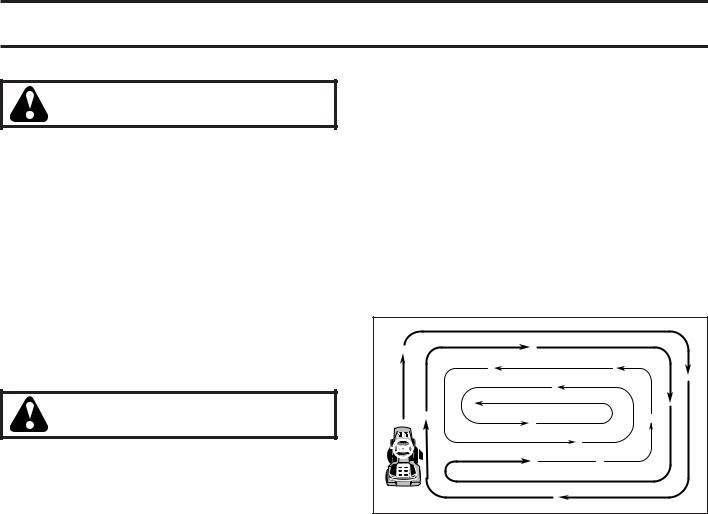
OPERATION
PURGE TRANSMISSION
CAUTION: Never engage or disengage freewheel lever while the engine is running.
To ensure proper operation and performance, it is recommended that the transmission be purged before operating tractor for the first time. This procedure will remove any trapped air inside the transmission which may have developed during shipping of your tractor.
IMPORTANT: SHOULD YOUR TRANSMISSION REQUIRE REMOVAL FOR SERVICE OR REPLACEMENT, IT SHOULD BE PURGED AFTER REINSTALLATION BEFORE OPERATING THE TRACTOR.
1.Place tractor safely on a level surface - that is clear and open - with engine off and parking brake set.
2.Disengage transmission by placing freewheel control in disengaged position. (See “TO TRANSPORT” in this section of manual.)
3.Sitting in the tractor seat, start engine. After the engine is running, move throttle control to slow position. Disengage parking brake
CAUTION: At any time, during step 4, there may be movement of the drive wheels.
4.Depress forward drive pedal to full forward position, hold for five (5) seconds and release pedal. Depress reverse drive pedal to full reverse position, hold for five
(5) seconds and release pedal. Repeat this procedure three (3) times.
5.Shutoff engine and set parking brake.
6.Engage transmission by placing freewheel control in engaged position. (See “TO TRANSPORT” in this section of manual.)
7.Sitting in the tractor seat, start engine. After the engine is running, move throttle control to half (1/2) speed. Disengage parking brake.
8.Drive tractor forward for approximately 5 feet (1,5 m) then backwards for 5 feet (1,5 m). Repeat this driving procedure three times.
Your transmission is now purged and now ready for normal operation.
MOWING TIPS
•DO NOT use tire chains when the mower housing is attached to tractor.
•Mower should be properly leveled for best mowing performance. See “TO LEVEL MOWER HOUSING” in the Service and Adjustments section of this manual.
•The left hand side of mower should be used for trimming.
•Drive so that clippings are discharged onto the area that has been cut. Have the cut area to the right of the tractor. This will result in a more even distribution of clippings and more uniform cutting.
•When mowing large areas, start by turning to the right so that clippings will discharge away from shrubs, fences, driveways, etc. After one or two rounds, mow in the opposite direction making left hand turns until finished (See Fig. 13).
Fig. 13
•If grass is extremely tall, it should be mowed twice to reduce load and possible fire hazard from dried clippings. Make first cut relatively high; the second to the desired height.
•Do not mow grass when it is wet. Wet grass will plug mower and leave undesirable clumps. Allow grass to dry before mowing.
•Always operate engine at full throttle when mowing to ensure better mowing performance and proper discharge of material. Regulate ground speed by selecting a low enough gear to give the mower cutting performance as well as the quality of cut desired.
•When operating attachments, select a ground speed that will suit the terrain and give best performance of the attachment being used.
13

MAINTENANCE
|
MAINTENANCE SCHEDULE |
BEFORE |
EVERY |
EVERY |
EVERY |
EVERY |
EVERY |
BEFORE |
|
EACH |
8 |
25 |
50 |
100 |
SEASON |
STORAGE |
|
|
|
|||||||
|
|
USE |
HOURS |
HOURS |
HOURS |
HOURS |
|
|
|
|
|
|
|
|
|
|
|
|
Check Brake Operation |
|
|
|
|
|
|
|
|
Check Tire Pressure |
|
|
|
|
|
|
|
|
|
|
|
|
|
|
|
|
T |
Check Operator Presence and ROS Systems |
|
|
|
|
|
|
|
|
|
|
|
|
|
|
|
|
Check for Loose Fasteners |
|
|
|
|
|
|
|
|
R |
|
|
|
|
|
|
|
|
A |
Check/Replace Mower Blades |
|
|
3 |
|
|
|
|
C |
Lubrication Chart |
|
|
|
|
|
|
|
T |
|
|
|
|
|
|
|
|
Check Battery Level |
|
|
4 |
|
|
|
|
|
O |
|
|
|
|
|
|
|
|
Clean Battery and Terminals |
|
|
|
|
|
|
|
|
R |
|
|
|
|
|
|
|
|
Clean Debris off Steering Plate |
|
|
5 |
|
|
|
|
|
|
|
|
|
|
|
|
||
|
|
|
|
|
|
|
|
|
|
Check Transaxle Cooling |
|
|
|
|
|
|
|
|
|
|
|
|
|
|
|
|
|
Check Mower Levelness |
|
|
|
|
|
|
|
|
|
|
|
|
|
|
|
|
|
Check V-Belts |
|
|
|
|
|
|
|
|
Check Engine Oil Level |
|
|
|
|
|
|
|
|
|
|
|
|
|
|
|
|
|
Change Engine Oil (models with oil filter) |
|
|
|
1,2 |
|
|
|
E |
Change Engine Oil (models without oil filter) |
|
|
1,2 |
|
|
|
|
|
|
|
|
|
|
|
||
Clean Air Filter |
|
|
2 |
|
|
|
|
|
N |
|
|
|
|
|
|
|
|
Clean Air Screen |
|
|
2 |
|
|
|
|
|
G |
|
|
|
|
|
|
||
|
|
|
|
|
|
|
||
Inspect Muffler/Spark Arrester |
|
|
|
6 |
|
|
|
|
I |
|
|
|
|
|
|
||
Replace Oil Filter (If equipped) |
|
|
|
|
|
|
|
|
N |
|
|
|
|
1, 2 |
|
|
|
|
|
|
|
|
|
|
|
|
E |
Clean Engine Cooling Fins |
|
|
|
|
2 |
|
|
|
Replace Spark Plug |
|
|
|
|
|
|
|
|
|
|
|
|
|
|
|
|
|
Replace Air Filter Paper Cartridge |
|
|
|
|
2 |
|
|
|
|
|
|
|
|
|
|
|
|
Replace Fuel Filter |
|
|
|
|
|
|
|
|
|
|
|
|
|
|
|
|
1 |
- Change more often when operating under a heavy load or in high ambient temperatures |
4 - Not required if equipped with maintenance-free battery |
2 |
- Service more often when operating in dirty or dusty conditions. |
5 - See Cleaning in Maintenance Section. |
3 |
- Replace blades more often when mowing in sandy soil. |
|
6 - Inspect the muffler every 50 hours of operation or six months for signs of damage. If damage is found, refer to the repair parts list or contact your local dealer to order a replacement.
GENERAL RECOMMENDATIONS
The warranty on this tractor does not cover items that have been subjected to operator abuse or negligence. To receive full value from the warranty, operator must maintain tractor as instructed in this manual.
Some adjustments will need to be made periodically to properly maintain your tractor.
At least once a season, check to see if you should make any of the adjustments described in the Service and Adjustments section of this manual.
•At least once a year you should replace the spark plug, clean or replace air filter, and check blades and belts for wear. A new spark plug and clean air filter assure proper air-fuel mixture and help your engine run better and last longer.
BEFORE EACH USE
•Check engine oil level.
•Check brake operation.
•Check tire pressure.
•Check operator presence and ROS systems for proper operation.
•Check for loose fasteners.
LUBRICATION CHART
SPINDLE ZERK |
SPINDLE ZERK |
|
FRONT |
FRONT |
|
WHEEL |
||
WHEEL |
||
BEARING |
||
BEARING |
||
ZERK |
||
ZERK |
||
|
||
STEERING |
ENGINE |
|
SECTOR |
|
|
GEAR |
|
|
TEETH |
|
01965
General Purpose Grease
Refer to Maintenance “ENGINE” Section
IMPORTANT: DO NOT OIL OR GREASE THE PIVOT POINTS WHICH HAVE SPECIAL NYLON BEARINGS. VISCOUS LUBRICANTS WILL ATTRACT DUST AND DIRT THAT WILL SHORTEN THE LIFE OF THE SELF-LUBRICATING BEARINGS. IF YOU FEEL THEY MUST BE LUBRICATED, USE ONLY A DRY, POWDERED GRAPHITE TYPE LUBRICANT SPARINGLY.
14
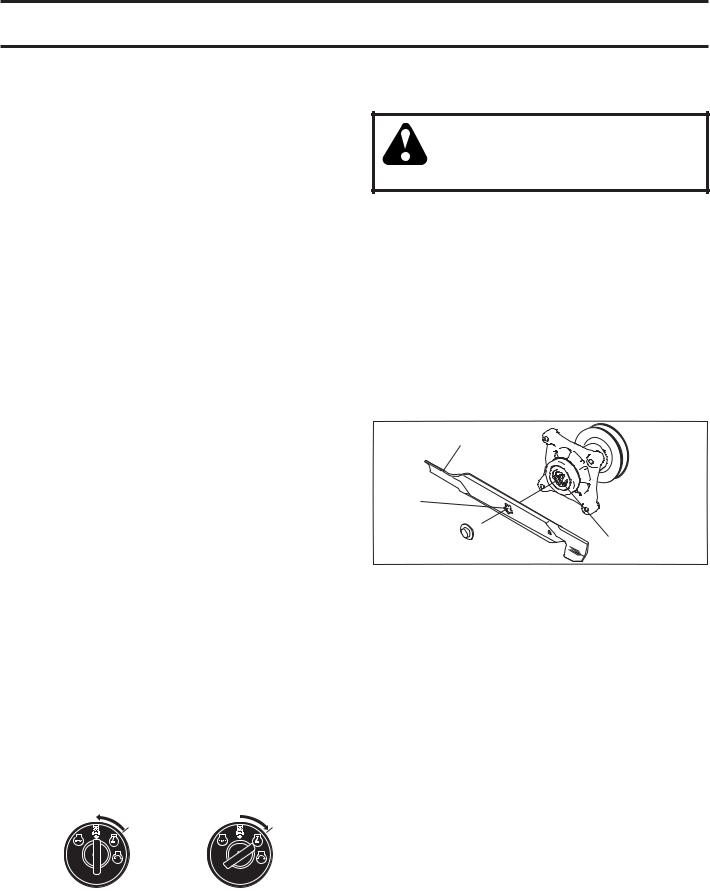
MAINTENANCE
TRACTOR
Always observe safety rules when performing any maintenance.
BRAKE OPERATION
If tractor requires more than five (5) feet (1,5 m) to stop at highest speed in highest gear on a level, dry concrete or paved surface, then brake must be checked and adjusted. (See “TO CHECK BRAKE” in the Service and Adjustments section of this manual.)
TIRES
•Maintain proper air pressure in all tires. (See the sides of tires for proper PSI.)
•Keep tires free of gasoline, oil, or insect control chemicals which can harm rubber.
•Avoid stumps, stones, deep ruts, sharp objects and other hazards that may cause tire damage.
NOTE: To seal tire punctures and prevent flat tires due to slow leaks, tire sealant may be purchased from your local parts dealer. Tire sealant also prevents tire dry rot and corrosion.
OPERATOR PRESENCE SYSTEM AND REVERSE OPERATION SYSTEM (ROS) (See Fig. 14)
Be sure operator presence and reverse operation systems are working properly. If your tractor does not function as described, repair the problem immediately.
•The engine should not start unless the brake pedal is fully depressed, and the attachment clutch control is in the disengaged position.
CHECK OPERATOR PRESENCE SYSTEM
•When the engine is running, any attempt by the operator to leave the seat without first setting the parking brake should shut off the engine.
•When the engine is running and the attachment clutch is engaged, any attempt by the operator to leave the seat should shut off the engine.
•The attachment clutch should never operate unless the operator is in the seat.
CHECK REVERSE OPERATION (ROS) SYSTEM
•When the engine is running with the ignition switch in the engine "ON" position and the attachment clutch engaged, any attempt by the operator to shift into reverse should shut off the engine.
•When the engine is running with the ignition switch in the ROS "ON" position and the attachment clutch engaged, any attempt by the operator to shift into reverse should NOT shut off the engine.
|
|
|
|
|
|
|
|
ROS "ON" |
ENGINE "ON" POSITION |
||
POSITION |
(NORMAL OPERATING) |
||
|
|
|
|
|
|
Fig. 14 |
|
BLADE CARE
For best results mower blades must be kept sharp. Replace bent or damaged blades.
CAUTION:Useonlyareplacementbladeapproved by the manufacturer of your tractor. Using a blade not approved by the manufacturer of your tractor is hazardous, could damageyourtractorandvoidyourwarranty.
BLADE REMOVAL (See Fig. 15)
•Raise mower to highest position to allow access to blades.
NOTE: Protect your hands with gloves and/or wrap blade with heavy cloth.
•Remove blade bolt by turning counterclockwise.
•Install new or resharpened blade with stamped "GRASS SIDE" facing the ground.
IMPORTANT: To ensure proper assembly, center hole in blade must align with star on mandrel assembly.
•Install and tighten blade bolt securely (45-55 Ft. Lbs./ 62-75 Nm).
IMPORTANT:SPECIALBLADEBOLTISHEATTREATED.
BLADE
CENTER
 HOLE
HOLE
BLADE 
 BOLT
BOLT
 (SPECIAL)
(SPECIAL)
 MANDREL ASSEMBLY
MANDREL ASSEMBLY
STAR
Fig. 15
BATTERY
Your tractor has a battery charging system which is sufficient for normal use. However, periodic charging of the battery with an automotive charger will extend its life.
•Keep battery and terminals clean.
•Keep battery bolts tight.
•Keep small vent holes open.
•Recharge at 6-10 amperes for 1 hour.
NOTE: The original equipment battery on your tractor is maintenance free. Do not attempt to open or remove caps or covers. Adding or checking level of electrolyte is not necessary.
TO CLEAN BATTERY AND TERMINALS
Corrosion and dirt on the battery and terminals can cause the battery to “leak” power.
• Remove terminal guard.
• Disconnect BLACK battery cable first then RED battery cable and remove battery from tractor.
• Rinse the battery with plain water and dry.
• Clean terminals and battery cable ends with wire brush until bright.
• Coat terminals with grease or petroleum jelly.
• Reinstall battery. (See “REPLACING BATTERY" in the Service and Adjustments section of this manual.)
15
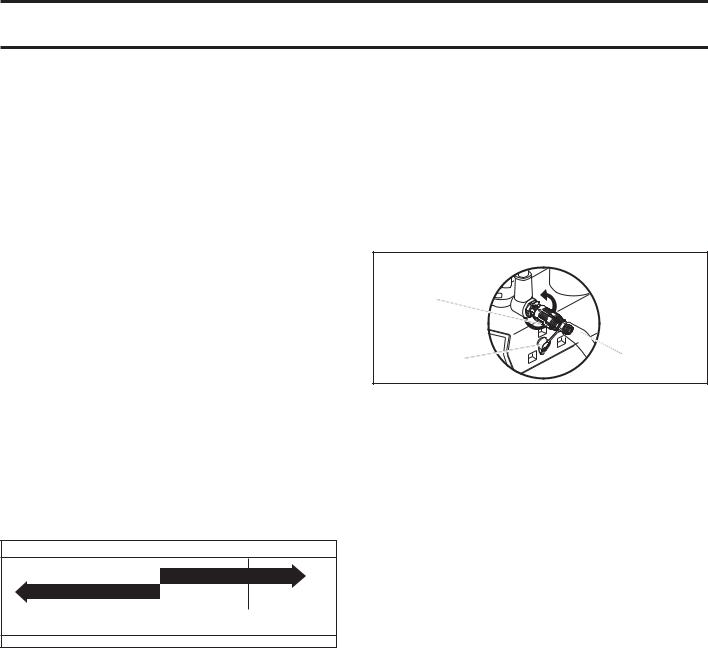
MAINTENANCE
V-BELTS
Check V-belts for deterioration and wear after 100 hours of operation and replace if necessary. The belts are not adjustable. Replace belts if they begin to slip from wear.
TRANSAXLE COOLING
The transmission fan and cooling fins should be kept clean to assure proper cooling.
Do not attempt to clean fan or transmission while engine is running or while the transmission is hot. To prevent possible damage to seals, do not use high pressure water or steam to clean transaxle.
•Inspect cooling fan to be sure fan blades are intact and clean.
•Inspect cooling fins for dirt, grass clippings and other materials. To prevent damage to seals, do not use compressed air or high pressure sprayer to clean cooling fins.
TRANSAXLE PUMP FLUID
The transaxle was sealed at the factory and fluid maintenance is not required for the life of the transaxle. Should the transaxle ever leak or require servicing, contact your nearest authorized service center/department.
ENGINE
LUBRICATION
Only use high quality detergent oil rated with API service classification SJ-SN. Select the oil’s SAE viscosity grade according to your expected operating temperature.
SAE VISCOSITY GRADES
|
|
|
|
|
|
|
|
|
|
SAE 30 |
|
|
|
|
|
|
5W-30 |
|
|
|
|
|
|
|
|
|
|
|
|
|
|
|
|
|
|
|
|
|
F |
-20 |
0 |
|
|
30 32 40 |
|
60 |
80 |
100 |
|||
C |
-30 |
-20 |
-10 |
0 |
10 |
20 |
30 |
40 |
||||
TEMPERATURE RANGE ANTICIPATED BEFORE NEXT OIL CHANGE
Fig. 16
NOTE: Although multi-viscosity oils (5W30, 10W30 etc.) improve starting in cold weather, they will result in increased oil consumption when used above 32°F/0°C. Check your engine oil level more frequently to avoid possible engine damage from running low on oil.
Change the oil after every 50 hours of operation or at least once a year if the tractor is not used for 50 hours in one year.
Check the crankcase oil level before starting the engine and after each eight (8) hours of operation. Tighten oil fill cap/dipstick securely each time you check the oil level.
TO CHANGE ENGINE OIL (See Fig. 17)
Determine temperature range expected before oil change. All oil must meet API service classification SJ-SN.
•Ensure tractor is on level surface.
•Oil will drain more freely when warm.
•Catch oil in a suitable container.
•Remove oil fill cap/dipstick. Be careful not to allow dirt to enter the engine when changing oil.
•Remove yellow cap from end of drain valve and install the drain tube onto the fitting.
|
OIL DRAIN VALVE |
|
CLOSED |
|
|
AND |
02463 |
|
LOCKED |
|
|
POSITION |
|
|
YELLOW CAP |
DRAIN |
|
TUBE |
||
|
Fig. 17
•Unlock drain valve by pushing inward and turning counterclockwise.
•To open, pull out on the drain valve.
•After oil has drained completely, close and lock the drain valve by pushing inward and turning clockwise until the pin is in the locked position as shown.
•Remove the drain tube and replace the cap onto to the bottom fitting of the drain valve.
•Refill engine with oil through oil fill dipstick tube. Pour slowly. Do not overfill. For approximate capacity see “PRODUCT SPECIFICATIONS” section of this manual.
•Use gauge on oil fill cap/dipstick for checking level. Ensure dipstick cap is tightened securely for accurate reading. Keep oil at “FULL” line on dipstick. Tighten cap onto the tube securely when finished.
ENGINE OIL FILTER
Replace the engine oil filter every season or every other oil change if the tractor is used more than 100 hours in one year.
16
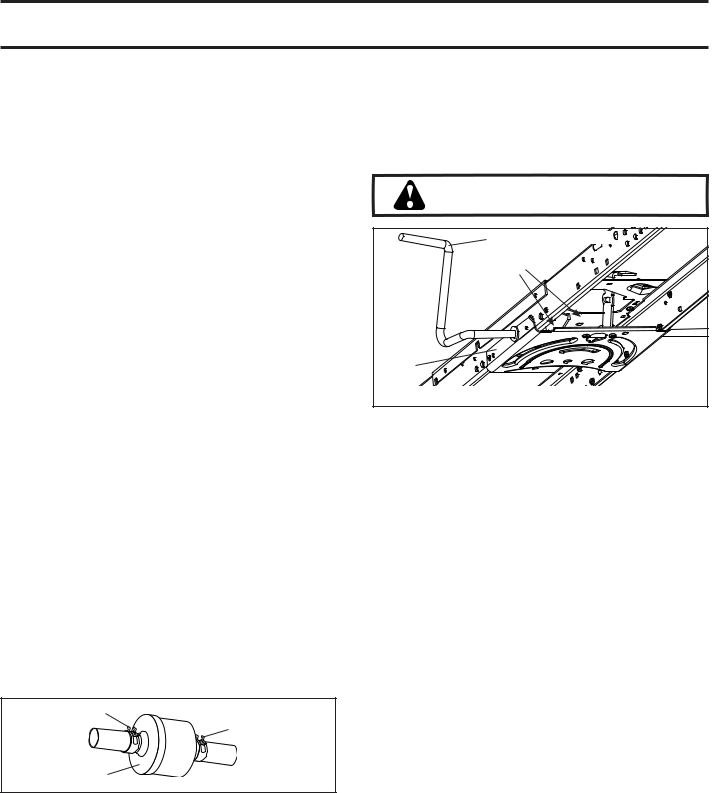
MAINTENANCE
AIR FILTER
Your engine will not run properly using a dirty air filter. Service air cleaner more often under dusty conditions.
CLEAN AIR SCREEN
The air screen is over the air intake blower located on top of engine. The air screen must be kept free of dirt and chaff to prevent engine damage from overheating. Clean with a wire brush or compressed air to remove dirt and stubborn dried gum fibers.
ENGINE COOLING SYSTEM
To ensure proper cooling, make sure the grass screen, cooling fins, and other external surfaces of the engine are kept clean at all times.
Every 100 hours of operation (more often under extremely dusty, dirty conditions), remove the blower housing and other cooling shrouds. Clean the cooling fins and external surfaces as necessary. Ensure the cooling shrouds are reinstalled.
NOTE: Operating the engine with a blocked grass screen, dirtyorpluggedcoolingfins,and/orcoolingshroudsremoved will cause engine damage due to overheating.
SPARK PLUGS
Replace spark plugs at the beginning of each mowing season or after every 100 hours of operation, whichever occurs first. Spark plug type and gap setting are shown in “PRODUCT SPECIFICATIONS” section of this manual.
MUFFLER
Inspect and replace corroded muffler and spark arrester (if equipped) as it could create a fire hazard and/or damage.
IN-LINE FUEL FILTER (See Fig. 18)
The fuel filter should be replaced once each season. If fuel filter becomes clogged, obstructing fuel flow to carburetor, replacement is required.
•Withenginecool,removefilterandplugfuellinesections.
•Place new fuel filter in position in fuel line with arrow pointing towards carburetor.
•Be sure there are no fuel line leaks and clamps are properly positioned.
•Immediately wipe up any spilled gasoline.
CLAMP
CLAMP
FUEL FILTER
Fig. 18
CLEANING
•Clean engine, battery, seat, finish, etc. of all foreign matter.
•Clean debris from steering plate. Debris can restrict clutch/brake pedal shaft movement, causing belt slip and loss of drive. See Fig. 19.
CAUTION: Avoid all pinch points and movable parts.
CLUTCH/BRAKE PEDAL |
CLEAN |
TOP SIDE |
STEERING |
PLATE |
STEERING SYSTEM, DASH, FENDER AND MOWER NOT SHOWN |
Fig. 19
•Keep finished surfaces and wheels free of all gasoline, oil, etc.
•Protect painted surfaces with automotive type wax.
Except for the washout port (if equipped), we do not recommend using a garden hose or pressure washer to clean the outside of your tractor unless the engine and transmission are covered to keep water out. Water in engine or transmission will shorten the useful life of your tractor. Use compressed air or a leaf blower to remove grass, leaves and trash from outside tractor and mower.
17
